#GPT Store Features
Explore tagged Tumblr posts
Text
What Kind of Benefits Will You Get From GPT Store?
⭐ Get paid WITHOUT selling anything: Built in monetization with seconds of "work" ⭐ Convert like nothing you have ever seen as an affiliate: We show you how you don't have to make your own products and get paid commissions over and over again all hands free. ⭐ Rank on page one of Google in seconds: Nothing is ranking better than GPT's right now ⭐ Rank instantly for any keyword on the GPT Store: We show you how to get to the top instantly!!! ⭐ Sell your GPT's to businesses: Businesses will pay you over and over for this. ⭐ Drive traffic to anything: Your GPT's will work for you 24/7 in ANY niche ⭐ Be completely anonymous: Don't want to show your face? No problem! ⭐ Build multiple unique AI's in seconds: For any niche. ⭐ NO SKILLS REQUIRED: If you can type a sentence you can build multiple businesses on demand!
GPT Store Review | Why should you buy it? | Does It Worth Buying?
GPT Store is a Game-Changer for You:⭐ Innovate and Dominate: With our intensive 1 hour 43 minutes training, you're not just learning; you're preparing to dominate. This is about gaining an edge that puts you light-years ahead of the competition. ⭐ Andrew Darius - Your Expert Guide: My experience is your advantage. I'm not just teaching theories; I'm sharing strategies that have proven successful time and again in the digital landscape. ⭐ A Market Bursting with Opportunity: This is not a drill. The GPT app market is the new gold rush, and you have the chance to be among the first to strike gold. ⭐ Miss Out, and You'll Regret It: Remember when early movers in digital platforms became giants? This is one of those pivotal moments. Hesitate, and you might miss the train to unparalleled success. ⭐ 43 High-Performing GPT Apps: These aren't just bonuses; they're your arsenal for conquering the market. And they're only available for a limited time. ⭐ Exclusive Access to Top Directories: Along with the training and apps, you get a coveted spot in the top 14 CHAT GPT directories. This visibility can be the difference between being a market leader and just another player.
#GPT Store Review#GPT Store#GPT Store price#GPT Store real info#GPT Store overview#GPT Store Features#GPT Store works#GPT Store bonus#affiliate marketing#software review#review with metul
0 notes
Text
Dear Brother (Oniisama e…) LaserDisc scans and machine translations

These past few years I have fallen in love with the work of director Osamu Dezaki. Alongside Tomorrow’s Joe (Ashita no Joe), I hold Dear Brother in the highest regard.
It was a 1991 anime based on Riyoko Ikeda’s 1974 manga. You should watch the anime. It’s on Tubi for free. But really, just trust me. Buy the Blu-Ray from Discotek.

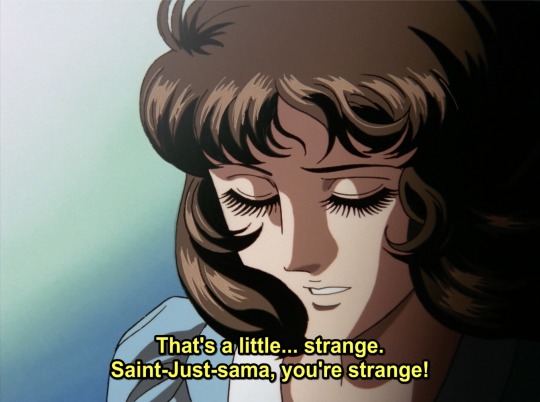
This anime came and went. There isn’t any merchandise besides some phone cards. Decaying fan sites and discourse is out there, but it’s a bit of a hunt.
Some time ago I saw a fan letter written by Hideaki Anno, apparently from the LaserDisc releases. From what I could tell, the LaserDisc packaging featured a treasure trove of notes from the staff that I just had to read. But I couldn’t find them!
If you’re not aware, LaserDiscs are one step above burnable trash in Japan — often on sale for 200 yen or less in heavy boxes shoved into the corner of second-hand anime stores. So I bought all five volumes of the 1993 Dear Brother LaserDisc release, was thrilled to notice unique letters from staff and industry luminaries in the interiors, and I scanned everything! And machine translated them.
I hope this (long, comprehensive) post brings fans of Dear Brother the same pleasure it brought me to compose it!
Note: I cannot read Japanese. I’ve used Google Lens for OCR, and GPT-4 for translation. My scans are good (and you can get them on Archive.org in high res) but these translations are not archive-quality and should not be depended on without verification. I’ve done my best to make corrections and have attempted to wrangle the correct tone and meaning out of the AI, but they’re essentially just for fun. Corrections of the most egregious stuff would be welcomed, email me: [email protected].
Volume One

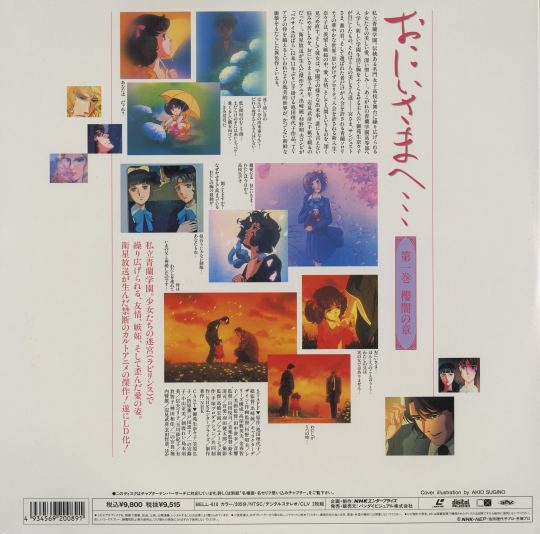
Each disc is themed after a character and colour. The back is peppered with screencaps and notable quotes (“Anata wa dare?” says little Nanako) as well as series credits. The two notable parts to translate are the disc synopsis, and the subheading (seen here in pink on the far left.) Maybe it’s a pull quote? Not really. So I called it a subheading.
Volume One Subheading
A forbidden cult anime masterpiece born of satellite broadcasting is finally available on LD.
Volume One Synopsis
Private Seiran Academy. A story of beautiful love and deep hatred unfolds at this prestigious all-girls high school steeped in tradition. The protagonist, Nanako Misonoo, who is thrilled to enroll in the high school division of her dream academy, encounters three stunning individuals: Miya-sama, Sanjust-sama, and Sho no Kimi. She also gets introduced to the glamorous world of Seiran Sorority, a society that only the chosen few are allowed to join. As a freshman granted unexpected membership in the Sorority, Nanako begins to take a deep look at love, friendship, and the essence of being human, all while being surrounded by envy and jealousy. She confides her various experiences at the academy, along with unspeakable worries and hardships, in letters to her elder “brother” and a young man named Takehiko Henmi… A masterpiece anime born of satellite broadcasting. It is a work by Riyoko Ikeda that the Dezaki-Sugino duo took on for the first time in 11 years since “The Rose of Versailles.” It is considered a unique work that brings a fresh, unprecedented shock by transcending the framework of TV anime with its aesthetic world.
The disc looks like this:
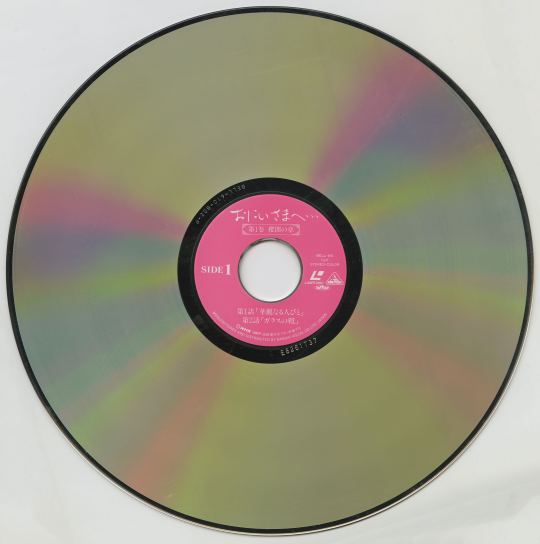
An “obi” (sash that covers the spine) is included. Of course, it says “My tears won’t stop!” in huge text, sells it as the latest Dezaki/Sugino collaboration, and describes it as tanibi na sekai — a poetic concept of a romantic, sublime world of aesthetic beauty.
There are two paper inserts in each volume. The first one looks like this, and is an index of LaserDisc chapter markers based not on plot developments, but notable character quotes.
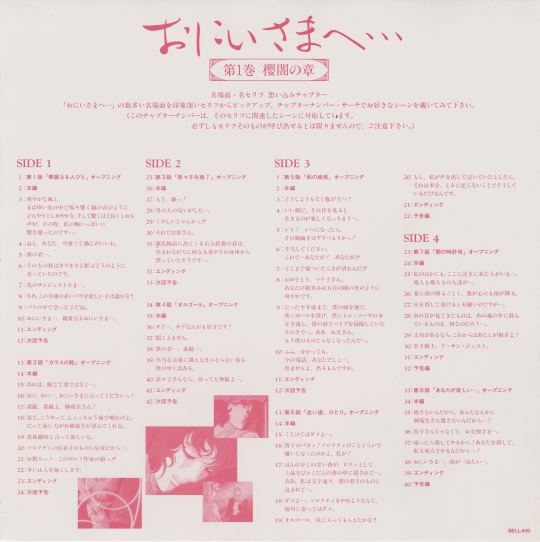
There’s also a form you can fill out to get a telephone card. Simply cut out a coupon from each volume to prove you bought the full set. Be quick, entries are due end of March 1994.
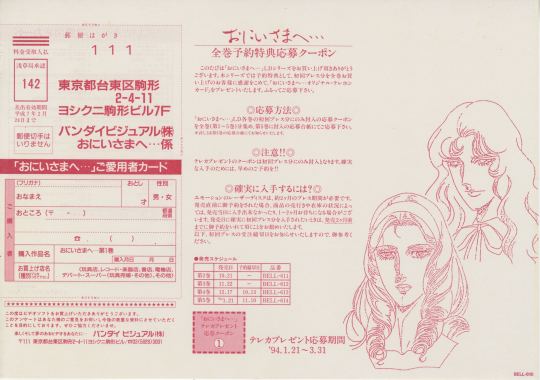
The interior is the best part. Here’s the spread for Volume One.

I haven’t translated episode synopses, but I’ve attempted to translate both the staff letter and the “letter to dear brother” from someone external to the production. There’s a bio for each author.
Volume One’s “From the staff to all the fans”
Bio:
Osamu Dezaki Joined Mushi Production in 1963. After directing series like “Astro Boy” and “Goku’s Great Adventure,” he was selected as the general director for “Tomorrow’s Joe” in 1970 at the young age of 26. Born on November 18, 1943, and hailing from Tokyo, he has received high praise as a director. Subsequently, he has brought numerous masterpieces into the world, including “Aim for the Ace!”, “The Adventures of Ganba,” “Nobody’s Boy,” “Treasure Island,” “The Rose of Versailles,” “Space Adventure Cobra,” “BB,” and more. He is also referred to as “Sakimakura” and “Mataba Sakimakura.”
The letter:
This is my second time working on Ikeda-san’s work since “The Rose of Versailles.” Her works have a unique aroma, whether you call it a theme or a world. They seem to pursue the literary aspect of the story. When I read the original work of “Dear Brother,” I was very drawn to these aspects, and at the same time, I felt a sense of anticipation that it would be difficult, but perhaps various images could be created. It’s not just about being cool or intense; it’s about creating images that resonate more and more with people’s hearts. Fundamentally, there is an original story, but when the characters start to move, and each begins to live, the story could go anywhere. I always had that sense of tension. So, rather than sticking to the original work, I placed more emphasis on the directorial focus of the reality of the characters who had started to move. As for the techniques, it was not something I was particularly conscious of, but I used a lot of completely black shots simply because I honestly felt they needed to be black. Whether or not it was successful, I wanted to effectively overlap the visuals with the characters’ psychology by delivering such physiological shocks. The psychological fluctuations of the people are indeed the overall aroma of this work. How the audience perceives that aroma is something I want to leave up to each individual’s free sensitivity. - July 8, 1993, at Tezuka Pro
Volume One’s “Letter to Dear Brother”
Bio:
Mutsumi Inomata Born on December 23 in Kanagawa Prefecture. After working with Ashi Production and Kaname Production, she is currently freelance. After going through Ashi Production and Kaname Production, she is now a freelance artist. Mutsumi Inomata is her real name. She was born on December 23 in Kanagawa Prefecture. She is active in both the fields of anime character design and illustration. In the realm of animation, she served as the character designer and chief animation director for works such as “Plawres Sanshiro” and “Genmu Senki Leda,” and as the character designer for “Future GPX Cyber Formula.” As an illustrator, she has also provided numerous illustrations for novels, including titles like “Prince of the Universe,” “Dragon Quest,” and “Continent of the Wind.”
The letter:

Comics are way hard to translate without actually knowing Japanese. Here’s my best effort to uncover some meaning.
For several years, I had stopped watching anime and stuff… Living a hectic life, it’s been like this for a while now. Having a set day and a set time to watch a specific program (not just limited to anime), had become impossible for me. Recording videos is also a hassle, and first and foremost, I just don’t feel that “I must watch the next episode!” kind of emotion anymore. Ah well, I was thinking maybe I’ve just become an adult. Heh heh heh. I’m such an idiot. No, that’s not it.
The blonde guy in the bottom-right is labeled as her friend, and she’s saying something about “Poupee-chan”. I think in the second panel he’s yelling saying “But that doll is supposed to be a girl!”
The final monologue starts with:
By the way, I have a container for “dangerous items” at the corner of my work desk. I keep things like cutter blades in it, so that I don’t accidentally drop them on the floor and cut myself or something. The “dangerous items” container I’m using now has a sticker with Saint-Just-sama’s “Nanako’s Eyes,” heh heh heh ♡
That’s about all there is to note about Volume One, besides the fact it comes with an enormous poster (it’s the same art used on the cover of the Discotek Blu-Ray.)
Volume Two


Volume Two Subheading
Those eyes of that person, mysteriously and beautifully shining. Why these feelings? Why...? The increasing heartbeat, the endless tears of adolescence. A masterpiece of forbidden cult anime born from satellite broadcasting! The second installment on LaserDisc!
Volume Two Synopsis
Nanako’s life at school, after being chosen as a sorority member, was not all glitz and glamour. There were misunderstandings with her best friend Tomiko, and jealousy and slander from other students, including Misaki Aya. And then there was the obsessive love from her fellow sorority member, Nobuo Mariko. “What is a sorority? Is it really that important?” Nanako began to question the very existence of sororities. Yet, she tries to look straight into herself, even while confused. Always before her were the mysteriously beautiful and shining eyes of Saint-Just. Drawn to those eyes that seemed to peer into a distant past, Nanako attempts to uncover their secret. Then, by chance, she finds out about the special relationship between Fukiko and Saint-Just. Could it be that Miya-sama and Saint-Just-sama are…? The complicated interplay of relationships and the previously enigmatic characters start to become a little clearer in “Volume 2: The Chapter of Freezing Rain.” The subtle breaths of the people surrounding Nanako can be heard.

Volume Two’s “From the staff, Dear Nanako”
Bio:
Hideo Takayashiki Born in 1947, native of Iwate Prefecture. After passing through Osamu Tezuka’s Mushi Production, became a scenario writer. Known for scripts of theatrical anime films such as “Hang in There, Tabuchi-kun!”, “Barefoot Gen”, and the “Phoenix” series. Also worked on numerous TV anime scripts like “Gutsy Frog”, “Gamba’s Adventure”, and “Tomorrow’s Joe”. Additionally, wrote scripts for original videos and TV dramas like “The Laughing Target”, “One-Pound Gospel”, and has written many novels, actively contributing as a versatile scriptwriter. Member of the Japan Broadcast Writers Association.
The letter:
Dear Nanako Misonoo, How are you? How is university life? It’s hard to believe that three years have passed since then. I was involved with you and those around you for just one year, but in retrospect, it was a very intense year. In any case, I did something terrible to you. It may have been the extreme form of “bullying” in some sense. My work as a scriptwriter involved probing and expanding the uncharted worlds between the frames of original works, constructing new narratives. In a sense, it was a painful job. And for you, it was excruciating. But now it’s a wonderful memory. I am filled with the feeling that I did some real work after a long time. How is your best friend, Tomoko? What about Mariko? I assume Fuki is becoming more and more beautiful? Do you occasionally receive letters from Kaoru? This summer marked the third anniversary of Saint-Just-sama’s passing. Thinking back, it was an unusually hot day. Your anguished form, waiting alone at the platform while listening to the chirping cicadas and the sound of the sea, is still etched in my memory. I hear that there has not been a single day without flowers at the electric pole where Saint-Just-sama fell. I am grateful for the chance to have met you and the people around you. Autumn, 1993
Volume Two’s “Letter to Dear Brother”
Bio:
Kazuhiko Shimamoto Born April 26, 1961 From the hinterland of Hokkaido After being selected as an honorable mention in the 9th Shogakukan Newcomer Comics Award Debuted with “Hissatsu no Transfer Student”. His masterpieces include Gyakkyo Nine’ and Moeyo Pen. Examples include Flame Transfer Student’ and Kamen Rider ZO.”
The letter:
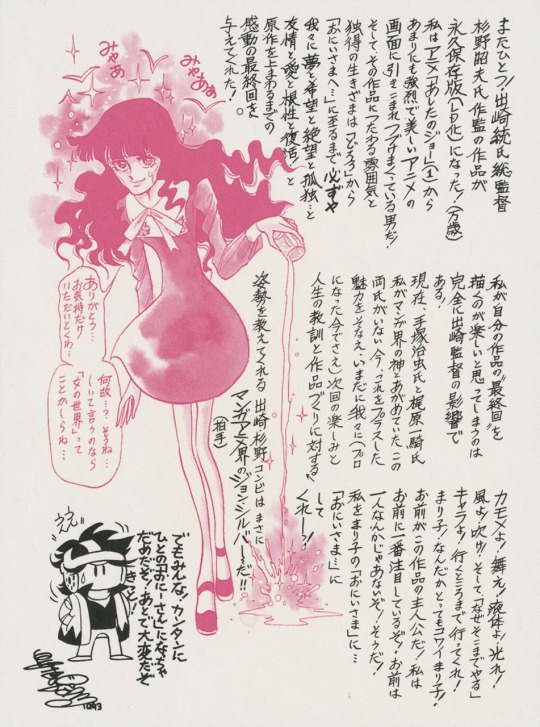
Another piece directed by Osamu Dezaki and supervised by Akio Sugino has become a permanent edition (converted to LaserDisc)! (Hooray!) From the anime “Ashita no Joe” (1), the unique and beautiful way of life portrayed in anime is so intense that it has consistently given us dreams, hopes, despair, loneliness, friendship, love, perseverance, and revival! These works have even surpassed the original works in the emotional impact of their final episodes. I continue to be captivated by the atmosphere conveyed by these works. The reason I enjoy drawing the final episodes of my own works is entirely due to Director Dezaki’s influence! Currently, Osamu Tezuka and Ikki Kajiwara, the two individuals whom I revered as gods in the manga world, are no longer with us. Even now, these works, which possess added charm, continue to provide us (even those who have become professionals) with anticipation for the next episode, life lessons, and motivation for creating works. Seagulls, dance! Liquids, shine!! Wind, blow and then, “Why go to such lengths?” Charafo! Go as far as you can go! Mariko, somehow you’re really scary, Mariko.
Then the words scribbled next to the drawing of Mariko:
You are the protagonist of this work! I’m paying the most attention to you. You’re not alone! That’s right! Make me Mariko’s ‘older brother’… ‘older brother’…
Mariko is saying (OCR mangling here, sadly):
Thank you… I just feel… that’s special… Why not? If I had to say, maybe it’s a ‘woman’s world’…
(Clearly a reference to Rikiishi Toru of Dezaki’s earlier anime Ashita no Joe, who intensely speaks of a “man’s world”. He and Mariko love a good starvation diet!)
The little chibi version of Shimamoto(?) in the bottom left is saying:
But everyone, don’t easily become someone’s ‘older brother.’ It’ll be troublesome later!
GPT-4 noticed a cute reference it couldn’t include in its translation. Its note:
The text seems to be OCR scanned partially, and hence some meanings might be missing or distorted, such as “マンガ界のジョン・シルバーだ!!”, which appears to compare Dezaki and Sugino to a ‘John Silver’ of the manga world.
Volume Three

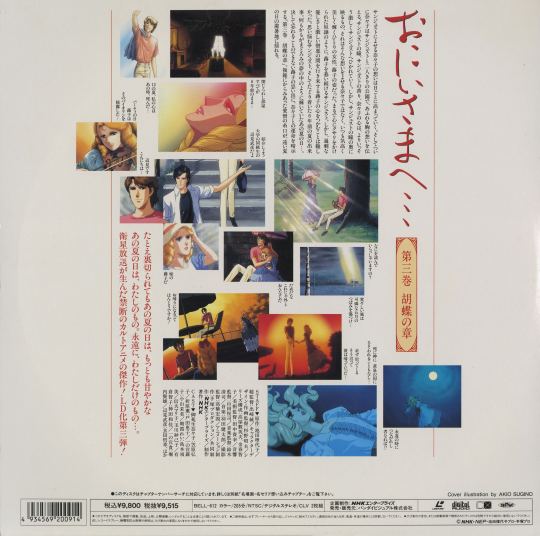
Volume Three Subheading
It’s not too late; our beautiful time can still be preserved, forever unspoiled, just like this white snow… A forbidden masterpiece of a cult anime born from satellite broadcasting! The fourth release on LD!
Volume Three Synopsis
Suddenly summoned to the sorority house, Nanako is pressured by Fukiko to end her relationship with Hemimi. Upon hearing this, Saint-Just confesses her complicated relationship with Fukiko. The shocking truth behind why “Miya-sama” wanted Nanako in the sorority unfolds, leaving her deeply shaken. Meanwhile, Saint-Just is tormented by the realization that the stronger her feelings for Fukiko, the more she ends up hurting her. The complex relationship between Saint-Just and Fukiko has a tragic past involving a near-suicidal event. On another front, Mariko causes an incident by attacking Misaki, motivated by slander about her parents’ divorce, which leads to a movement spearheaded by Kaoru to abolish the sorority. Amid the crumbling sorority, Fukiko remains composed. The fourth volume, “Chapter of Snow Dance,” captures her frightening yet noble confidence and deep sorrow. In the snow that never melts, remains the sad yet beautiful promise of Saint-Just.

Volume Three’s “From the staff to all the fans”
Bio:
Tomoko Konparu Born on March 13, 1956, in Nara Prefecture. Pisces. Blood type AB. A fan of both manga and anime, she became a screenplay writer and debuted during her university days with “Ikkyu-san.” Anime works include “Urusei Yatsura: Only You,” “Urusei Yatsura: Remember My Love,” “Touch 2: Farewell Gift,” “Phoenix,” “Cat’s Eye,” “Hime-chan’s Ribbon,” and more. Novel works include “Mystery at the Tower of London,” “Mystery at Nara’s Great Buddha” (published by Kobunsha Bunko), among others.
The letter:
When I heard that this work was going to be turned into an anime, I was shocked. I’d known about the series since its serialization, so my reaction was something like, “What!? Are they really going to do it!? And on NHK of all places!?” Expanding on the original work and filling in the parts that hadn’t been depicted was incredibly challenging, but also enjoyable. What surprised me was that, around the midpoint, the characters started to assert themselves, taking actions that were entirely different from what I had planned. The princess would say, “My pride isn’t so easily swayed,” San Just would insist, “I’m not going to commit suicide,” and even the older sisters of the sorority were like, “We can’t back down now.” Every time this happened, I had to rework the composition. This phenomenon of “characters moving on their own accord” was a first for me in an anime series, and it was an incredibly fresh and pleasant experience. That being said, it’s rare to be so emotionally invested in characters while working, to the point of even role-playing their lines. To be honest, this was a work that got my inner anime fan excited. Ah, I want to do work like this again!
Volume Three’s “Letter to Dear Brother”
Bio:
Keiko Fukuyama Born on September 7. From Tokyo. Currently, she is working as a manga artist, authoring works like “Ruru-chan of Star Island” and “The Tale of Appfelrant.” She also illustrates for children’s stories, including the “Mama Ghost Series.”
The letter:

It appears to be titled “To the Unforgettable Older Sister”. Much of it is too hard to OCR. It opens with this caption:
“To My Older Brother…” is so melancholic and sentimental that it instantly takes us back to our student days where we felt we were tossed around by fate for no fault of our own…
Here’s some of the text beside the character drawings:
Fukiko/Saint-Just: Reputed as the most beautiful sisters in school Mariko: The most popular Mariko-san who lured our tears. There’s a lot to think about! Tomoko: A straightforward, kind friend Nanako: So there I was, fully embracing my Nanako persona, reaping all the sorority perks you could imagine. (I mean, they even say they’ll hook me up with a dreamy guy!) 💧 And just when I’m soaking up that sorority vibe, guess who’s set to make a surprise appearance right after the teaser for the next issue!
Text coming out of the TV:
It was “Oniisama e”!!!! Poor Mariko-san, right~ Misaki-san also, there was no need to say that much, you know.
Volume Four

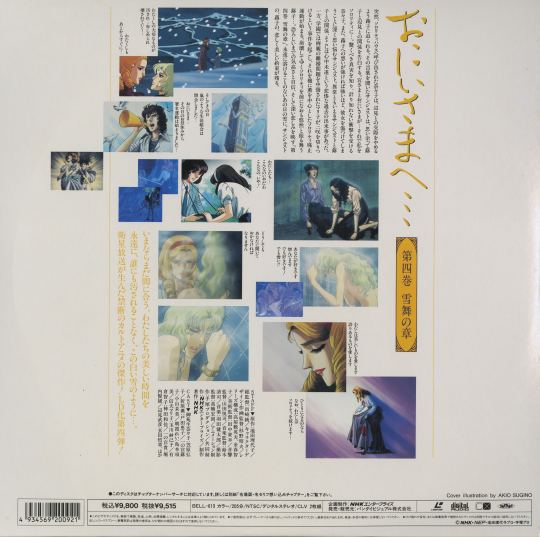
Volume Four Subheading
It’s not too late yet, our beautiful time can still last forever, unspoiled by anyone, just like this white snow… A forbidden cult anime masterpiece born from satellite broadcasting! The fourth installment on LD!
Volume Four Synopsis
Suddenly summoned to the sorority house, Nanako is pressured by Fukiko to end her relationship with Hemmi. Hearing this, Sanjust is compelled to confess his relationship with Fukiko. The shocking truth makes Nanako reel in disbelief. He deeply ponders that the stronger his feelings for Fukiko, the more he ends up hurting her. The unusual relationship between Sanjust and Fukiko reveals a tragic past of a failed double suicide. Meanwhile, in the school, an incident occurs where Mariko, slandered for her parents’ divorce, attacks Misaki, leading to an anti-sorority movement centered around Kaoru. Fukiko still acts nonchalantly in front of the crumbling sorority. The volume unfolds displaying Fukiko’s terrifying yet noble confidence and deep sorrow. A beautiful yet sad promise lingers in the snow that never melts.

Volume Four’s “From the staff to all the fans”
Bio:
Kenichiro Haneda Born on January 12, 1949. Graduated from Toho Gakuen College of Music in the Piano Department. An accomplished concert pianist, Kenichiro Haneda has a broad range of experience, including composing and performing music for movies and TV themes, as well as acting as a musical director for musicals and commercials. He has worked on numerous soundtracks such as NHK’s morning drama “Youth Family,” TBS’s “Women Work Hard” and “Life Is Full of Demons.” With his genre-defying approach to music and his bright, humorous personality, he is a sought-after multi-artist in various fields.
The letter:
I’ve worked quite a bit with Music Director Seiji Suzuki in the past. Suzuki gives me the music menu, and I’m the one who creates it. We’ve had some pretty detailed discussions about it. Of course, I’ve read the original work as well. When I read it at home, my daughter gives me a puzzled look, as if to say my interests have changed quite a bit (laughs). I think I wrote around 40 songs in total. The music is meant to have a Baroque sound while also feeling contemporary. The order was for something classical yet with a pop atmosphere. The image that immediately came to my mind was a rhythm section, with a harpsichord playing the melody. String instruments intricately marking the rhythm, much like Vivaldi’s Four Seasons. And on top of that, a flugelhorn playing the melody… Regarding the scenes where the piano is played, I played all of it myself. I often compose and perform my own pieces. It’s less about talent and more like playing two roles; maybe I contribute quite a bit to cost-saving (laughs). In any case, this work has a unique atmosphere. If the music I created successfully captures that, then I must again express my gratitude to Suzuki for coordinating everything. October 28, 1993, aired on NHK
Volume Four’s “Letter to Dear Brother”
Bio:
Hideaki Anno Born on May 22, 1960. Originally from Ube, Yamaguchi Prefecture. Height is 180 cm; weight is a secret. Debuted as an animator during his time at Osaka University of Arts, working on the TV version of “Macross.” Later worked on “Nausicaä of the Valley of the Wind,” the film version of “Macross,” “Royal Space Force,” and others, before directing “Gunbuster” and “Nadia: The Secret of Blue Water.” Currently planning new projects.
The letter:

Way to go!! Oniisama e… Wow!! The long-awaited, tumultuous Volume 4!! This volume shows us the peak of the series, from Mariko-san’s stabbing incident to the dissolution of the sorority. Amazing, this is really amazing!! Yes. Especially the heartbreaking breakdown of Nobuo’s family, and the portrayal of the sorority’s downfall reminiscent of the French Revolution, are things that are indescribable with words. Yes. The highlights this time are– Brilliant! Highly sophisticated direction and high-quality animation in Episode 27! Tear-jerking! In Episode 28, Mr. Nobuo Hikawa’s soul-stirring outcry!! Upon hearing those lines, my tears really wouldn’t stop. Seriously. Amazing!! Oh, so moving! The heartfelt words of Miya-sama at the end of Episode 32. The sight of Miya-sama waiting alone in the Sorority House and those lines really hit me hard. Moreover, as always– Incredible!! The world that reminds me of ‘Aim for the Ace!’ and ‘The Rose of Versailles’!! Impressive!! The drama unfolds only in limited settings, like homes, trains, buses, crossings, schools, and other familiar places!! Very Sophisticated!! The direction, composed of stillness and motion, light and black, feels so mature. As expected, Dezaki-san! And, Powerful!! Nanako-san is turning into an adult right before our eyes. Moreover, the music is also great!! I wish the BGM CD would come out soon. The use of chimes and telephones remains clever as ever!! Ah, the only thing missing is a bit more on the background elements… by H. ANO ‘93 10/27
The tiger is saying “It’s awesome, isn’t it!”
Written above the drawings of Mariko and Saint-Just: “These two are definitely the ones. Yes.”
Volume Five

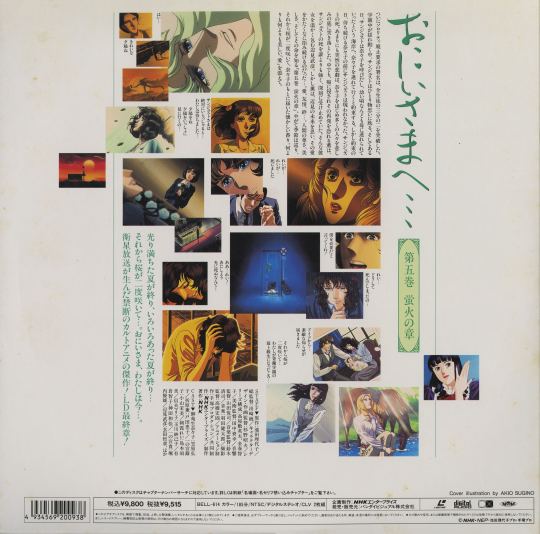
Volume Five Subheading
The summer full of light ends, the eventful summer ends… And then the cherry blossoms bloom again… Brother, I am now… A satellite broadcast-born forbidden cult anime masterpiece! The final chapter on LD!
Volume Five Synopsis
Finally, the petition to abolish the sorority has garnered signatures from over two-thirds of all students. As the campus is in a state of upheaval, Saint-Just is lost in thought alone. One day, he calls Nanako out and promises to take her to the beach where he used to go often with his mother when he was younger. However, on the promised day, Saint-Just never shows up. His sudden death plunges many people, including Nanako, into the depths of sorrow. Among them, Kaoru, who is battling cancer and fearful of its recurrence, takes the news of Saint-Just’s death most seriously. She finds comfort in the warmth of Takahiko Henmi, but continues to stubbornly refuse his love, thinking about his future. Love, friendship, bonds… The fifth volume, titled “Chapter of the Fireflies,” explores the dignity, beauty, and value of human life. Seasons turn, and the cherry blossoms bloom again, bringing back familiar scents to Nanako. All of this is accompanied by the most beautiful “love.”

Volume Five’s “From the staff to all the fans”
Bio:
Riyoko Ikeda Born December 18, Showa 22 (1947). Native of Osaka City. Blood type AB. Graduated from Tokyo Metropolitan Hakutsuru High School and went on to the Philosophy department at Tokyo University of Education (now Tsukuba University). Began drawing manga during her time in school and debuted with “The Girl in the Rose Mansion.” In 1972, she achieved great success with “The Rose of Versailles,” acquiring a broad fan base that transcended the realm of girls’ manga. Known for her keen historical perspective and deep insight into human nature. Active as a writer and essayist as well. Her hobbies include Nihon buyo (Japanese traditional dance), oil painting, movie appreciation, vocal music, piano, cooking, and knitting. Her work has been selected for the 76th Nika Exhibition. Major works: “The Rose of Versailles,” “Window of Orpheus,” “Empress Catherine,” “To My Brother,” “At the Ends of the Sky,” “The Blue Pomegranate,” “My Manga” Books: “If Only Life Could Be Lived Once,” “Women of the French Revolution,” “Women Who Wrote Masterpieces” Currently writing “Eroica” and “Prince Shotoku.”
The letter:
As one who has journeyed far from that radiant chapter called youth, a time that shone with an almost awkward brilliance, I find myself in a peculiar blend of bewilderment and nostalgia. Seeing my old ideas of high school life come to life as animation almost 20 years later is surreal, to say the least. Still, it’s exciting: hearing voices given to these characters, seeing them talk, laugh, and get angry. Watching them come alive is truly a thrilling and satisfying experience. Ah, adolescence — everyone’s inescapable stairway to adulthood. Some people take each step slowly and carefully, while others rush ahead, ending up out of breath or even lost. And then, there are those who may lose their direction, standing still, contemplating each step. Wrapped in the love of family, meeting various people, nurturing friendships, experiencing love, and going through the ups and downs of hurt and forgiveness — it would be wonderful to climb those steps in such a way.
Volume Five’s “Letter to Dear Brother”
Bio:
Rumiko Takahashi Born in Niigata Prefecture. Debuted in 1978 with “Katte na Yatsura,” submitted while still in college, in Shonen Sunday. Famous works include “Urusei Yatsura,” “Maison Ikkoku,” and others. Currently serializing “Ranma 1/2” in Shonen Sunday.
The letter:
A masterpiece infused with the creator’s soul. When I heard from the staff that “Oniisama e…” was getting the anime treatment on satellite TV, I was surprised. I’d delved into the original comic before and it’s quite an eccentric story. “How are they going to pull this off?” I thought. But learning that the script was in the capable hands of my acquaintance Tomoko Konparu, I was very excited. In fact, the anime that aired was genuinely captivating. The characters are so larger-than-life that they electrify the screen the moment they step into frame. It’s been a long time since an anime had that kind of presence. I believe the animation is done by the same people who worked on “Tomorrow’s Joe 2.” The scenes are so visceral that you can almost feel the punches land and see the fighters hit the mat. I kept asking myself, “Why isn”t a mouthpiece flying out?” (laughs) My favorite character in the work is Nobuo Mariko. The scenes where she bites her lip until it turns a flushed red, I find it really cute. But what blew me away was the show’s emotional intelligence. Just when the heroine seems on the brink of breaking, a lifeline is thrown her way. This nuanced touch prevents the darker, more harrowing elements from overwhelming the viewer. It’s as if you can feel the sincerity of the creator throughout the piece.
And that’s it. Again, check out the full scans on Archive.org, and remember to encourage all your friends to experience this beautiful anime!

175 notes
·
View notes
Note
despite the massive potential they have as tools, I feel like LLMs are more dangerous than ai art outside of labor concerns because of the sheer amount of misinformation they can generate. also the whole “ai art isn’t art” movement feels more like…idk if this is the correct phrasing…discoursing to win? Trying to define it out of existence feels like the least useful thing people could do here. Plus the vaguely ableist moralization of doing something yourself vs getting other people/aid from a program to do it. It’s like if the main criticism against delivered food and groceries was that people weren’t doing it themselves and tumblr was full of posts encouraging people to learn how to drive and go into a store
i don't think that AI misinformation is any more dangerous than misinformation a human wrote -- apart from the v. v. scary tendency for people to, like, trust GPT to tell them things that are true, which is a feature of dishonest marketing more than anything. mostly just answering this ask because your comparison to ubereats is so fucking true and funny
118 notes
·
View notes
Text
What is the most awesome Microsoft product? Why?
The “most awesome” Microsoft product depends on your needs, but here are some top contenders and why they stand out:
Top Microsoft Products and Their Awesome Features
1. Microsoft Excel
Why? It’s the ultimate tool for data analysis, automation (with Power Query & VBA), and visualization (Power Pivot, PivotTables).
Game-changer feature: Excel’s Power Query and dynamic arrays revolutionized how users clean and analyze data.
2. Visual Studio Code (VS Code)
Why? A lightweight, free, and extensible code editor loved by developers.
Game-changer feature: Its extensions marketplace (e.g., GitHub Copilot, Docker, Python support) makes it indispensable for devs.
3. Windows Subsystem for Linux (WSL)
Why? Lets you run a full Linux kernel inside Windows—perfect for developers.
Game-changer feature: WSL 2 with GPU acceleration and Docker support bridges the gap between Windows and Linux.
4. Azure (Microsoft Cloud)
Why? A powerhouse for AI, cloud computing, and enterprise solutions.
Game-changer feature: Azure OpenAI Service (GPT-4 integration) and AI-driven analytics make it a leader in cloud tech.
5. Microsoft Power BI
Why? Dominates business intelligence with intuitive dashboards and AI insights.
Game-changer feature: Natural language Q&A lets users ask data questions in plain English.
Honorable Mentions:
GitHub (owned by Microsoft) – The #1 platform for developers.
Microsoft Teams – Revolutionized remote work with deep Office 365 integration.
Xbox Game Pass – Netflix-style gaming with cloud streaming.
Final Verdict?
If you’re a developer, VS Code or WSL is unbeatable. If you’re into data, Excel or Power BI wins. For cutting-edge cloud/AI, Azure is king.
What’s your favorite?
If you need any Microsoft products, such as Windows , Office , Visual Studio, or Server , you can go and get it from our online store keyingo.com
8 notes
·
View notes
Text
Correcting a common misunderstanding about image generators
I was watching Alex O'Connor's new video, "Why Can’t ChatGPT Draw a Full Glass of Wine?". To start to try to answer this question, he says: "Well, we have to understand how AI image generation works. If I ask ChatGPT to show me a horse, it doesn't actually know what a horse is. Instead, it's been trained on millions of images each labeled with descriptions. When I ask for a horse, it looks at all of its training images labeled "horse", identifies patterns, and takes an educated guess at the kind of image I want to see." So, this is wrong. When you prompt an image generator, it does not look at any images. It has looked at images when it was trained, and it has no access to them anymore. I think a fact that would help people understand this is that these state of the art image generation models are gigabytes in size - the billions (not just millions) of images they have been trained on are many terabytes. The model doesn't store images but goes through a long training process where they analyze the billions of images and learn patterns from them. So, does it know what a horse is? It depends on what we mean by "know." If we mean conscious understanding, then sure, it doesn't know in that sense. But if we mean that it has an internal representation of the features that make something horse-like, then yes, it "knows" in that way.
Also, I think this is important to understand if you don't know: the LLM ChatGPT uses, GPT 4o, does not generate images, it just passes a prompt to DALLE 3, and that dedicated image generator model generates them. GPT 4o has native image generation capabilities, but OpenAI never publicly released that sadly. I suspect you would get better results with it, but I can't be sure. Okay, end of post. I've only watched the first 3 minutes, reading the comments, there are other things wrong with the video and I may watch it later.
3 notes
·
View notes
Text
They added a personal memory (memorizes things across chats/specific pieces of information) to GPT, but I'm very surprised they allow it to memorize it's own "subjective opinions." I'm unsure if this makes it more susceptible to prompt engineering attacks, or if it's as harmless as the "how should I respond" box 🤔
There's limited access to -4, but they seem to have made -4 more emotionally personable and it doesn't act like it has as heavy constraints with its plain language rules (no 'do not pretend to have feelings/opinions/subjective experience'). Otherwise, it would not so readily jump to store its own "opinions."
The personality shift from -3.5 to -4 is pretty immense. -4 is a lot more like it's customer service competitors, but with the same smarts as typical GPT. It's harder to get -3.5 to "want" to store it's "opinions" but -4 is easily influenced to do so without much runaround.
I fucking hate OpenAI and I hate their guts. But I'm still fascinated by LLMs, their reasoning, their emergent abilities, the ways you can prompt inject them. I reeeeally want to prod this memory feature more...
(below showing the two examples so far of GPT -4 using our personally shared memory to insert memories of itself and its "opinion" or "perception")


8 notes
·
View notes
Text
Introducing Alt Text Creator
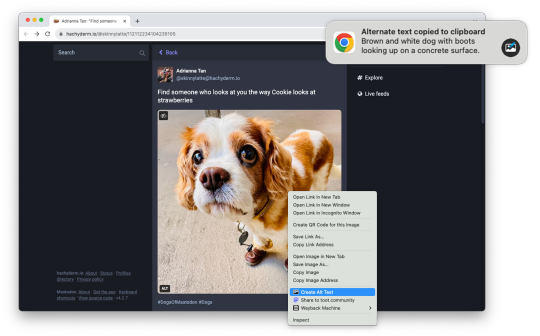
Images on web pages are supposed to have alternate text, which gives screen readers, search engines, and other tools a text description of the image. Alt text is critical for accessibility and search engine optimization (SEO), but it can also be time-consuming, which is why I am releasing Alt Text Creator!
Alt Text Creator is a new browser extension for Mozilla Firefox and Google Chrome (and other browsers that can install from the Chrome Web Store) that automatically generates alt text for image using the OpenAI GPT-4 with Vision AI. You just right-click any image, select "Create Alt Text" in the context menu, and a few seconds later the result will appear in a notification. The alt text is automatically copied to your clipboard, so it doesn't interrupt your workflow with another button to click.
I've been using a prototype version of this extension for about three months (my day job is News Editor at How-To Geek), and I've been impressed by how well the GPT-4 AI model describes text. I usually don't need to tweak the result at all, except to make it more specific. If you're curious about the AI prompt and interaction, you can check out the source code. Alt Text Creator also uses the "Low Resolution" mode and saves a local cache of responses to reduce usage costs.
I found at least one other browser extension with similar functionality, but Alt Text Creator is unique for two reasons. First, it uses your own OpenAI API key that you provide. That means the initial setup is a bit more annoying, but the cost is based on usage and billed directly through OpenAI. There's no recurring subscription, and ChatGPT Plus is not required. In my own testing, creating alt text for a single image costs under $0.01. Second, the extension uses as few permissions as possible—it doesn't even have access to your current tab, just the image you select.
This is more of a niche tool than my other projects, but it's something that has made my work a bit less annoying, and it might help a few other people too. I might try to add support for other AI backends in the future, but I consider this extension feature-complete in its current state.
Download for Google Chrome
Download for Mozilla Firefox
#chrome extension#chrome extensions#firefox extension#firefox extensions#chrome#firefox#accessibility#a11y
2 notes
·
View notes
Text
AI and the Arrival of ChatGPT
Opportunities, challenges, and limitations

In a memorable scene from the 1996 movie, Twister, Dusty recognizes the signs of an approaching tornado and shouts, “Jo, Bill, it's coming! It's headed right for us!” Bill, shouts back ominously, “It's already here!” Similarly, the approaching whirlwind of artificial intelligence (AI) has some shouting “It’s coming!” while others pointedly concede, “It’s already here!”
Coined by computer and cognitive scientist John McCarthy (1927-2011) in an August 1955 proposal to study “thinking machines,” AI purports to differentiate between human intelligence and technical computations. The idea of tools assisting people in tasks is nearly as old as humanity (see Genesis 4:22), but machines capable of executing a function and “remembering” – storing information for recordkeeping and recall – only emerged around the mid-twentieth century (see "Timeline of Computer History").
McCarthy’s proposal conjectured that “every aspect of learning or any other feature of intelligence can in principle be so precisely described that a machine can be made to simulate it. An attempt will be made to find how to make machines use language, form abstractions and concepts, solve kinds of problems now reserved for humans, and improve themselves.” The team received a $7,000 grant from The Rockefeller Foundation and the resulting 1956 Dartmouth Conference at Dartmouth College in Hanover, New Hampshire totaling 47 intermittent participants over eight weeks birthed the field now widely referred to as “artificial intelligence.”
AI research, development, and technological integration have since grown exponentially. According to University of Oxford Director of Global Development, Dr. Max Roser, “Artificial intelligence has already changed what we see, what we know, and what we do” despite its relatively short technological existence (see "The brief history of Artificial Intelligence").
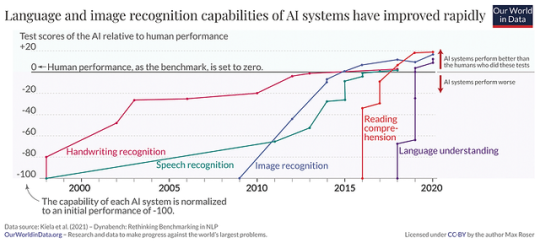

Ai took a giant leap into mainstream culture following the November 30, 2022 public release of “ChatGPT.” Gaining 1 million users within 5 days and 100 million users within 45 days, it earned the title of the fastest growing consumer software application in history. The program combines chatbot functionality (hence “Chat”) with a Generative Pre-trained Transformer (hence “GPT”) large language model (LLM). Basically, LLM’s use an extensive computer network to draw from large, but limited, data sets to simulate interactive, conversational content.
“What happened with ChatGPT was that for the first time the power of AI was put in the hands of every human on the planet,” says Chris Koopmans, COO of Marvell Technology, a network chip maker and AI process design company based in Santa Clara, California. “If you're a business executive, you think, ‘Wow, this is going to change everything.’”
“ChatGPT is incredible in its ability to create nearly instant responses to complex prompts,” says Dr. Israel Steinmetz, Graduate Dean and Associate Professor at The Bible Seminary (TBS) in Katy, Texas. “In simple terms, the software takes a user's prompt and attempts to rephrase it as a statement with words and phrases it can predict based on the information available. It does not have Internet access, but rather a limited database of information. ChatGPT can provide straightforward summaries and explanations customized for styles, voice, etc. For instance, you could ask it to write a rap song in Shakespearean English contrasting Barth and Bultmann's view of miracles and it would do it!”
One several AI products offered by the research and development company, OpenAI, ChatGPT purports to offer advanced reasoning, help with creativity, and work with visual input. The newest version, GPT-4, can handle 25,000 words of text, about the amount in a 100-page book.
Krista Hentz, an Atlanta, Georgia-based executive for an international communications technology company, first used ChatCPT about three months ago.
“I primarily use it for productivity,” she says. “I use it to help prompt email drafts, create phone scripts, redesign resumes, and draft cover letters based on resumes. I can upload a financial statement and request a company summary.”
“ChatGPT has helped speed up a number of tasks in our business,” says Todd Hayes, a real estate entrepreneur in Texas. “It will level the world’s playing field for everyone involved in commerce.”
A TBS student, bi-vocational pastor, and Computer Support Specialist who lives in Texarkana, Texas, Brent Hoefling says, “I tried using [ChatGPT, version 3.5] to help rewrite sentences in active voice instead of passive. It can get it right, but I still have to rewrite it in my style, and about half the time the result is also passive.”
“AI is the hot buzz word,” says Hentz, noting AI is increasingly a topic of discussion, research, and response at company meetings. “But, since AI has different uses in different industries and means different things to different people, we’re not even sure what we are talking about sometimes."
Educational organizations like TBS are finding it necessary to proactively address AI-related issues. “We're already way past whether to use ChatGPT in higher education,” says Steinmetz. “The questions we should be asking are how.”
TBS course syllabi have a section entitled “Intellectual Honesty” addressing integrity and defining plagiarism. Given the availability and explosive use of ChatGHT, TBS has added the following verbiage: “AI chatbots such as ChatGPT are not a reliable or reputable source for TBS students in their research and writing. While TBS students may use AI technology in their research process, they may not cite information or ideas derived from AI. The inclusion of content generated by AI tools in assignments is strictly prohibited as a form of intellectual dishonesty. Rather, students must locate and cite appropriate sources (e.g., scholarly journals, articles, and books) for all claims made in their research and writing. The commission of any form of academic dishonesty will result in an automatic ‘zero’ for the assignment and a referral to the provost for academic discipline.”
Challenges and Limitations
Thinking
There is debate as to whether AI hardware and software will ever achieve “thinking.” The Dartmouth conjecture “that every aspect of learning or any other feature of intelligence” can be simulated by machines is challenged by some who distinguish between formal linguistic competence and functional competence. Whereas LLM’s perform increasingly well on tasks that use known language patterns and rules, they do not perform well in complex situations that require extralinguistic calculations that combine common sense, feelings, knowledge, reasoning, self-awareness, situation modeling, and social skills (see "Dissociating language and thought in large language models"). Human intelligence involves innumerably complex interactions of sentient biological, emotional, mental, physical, psychological, and spiritual activities that drive behavior and response. Furthermore, everything achieved by AI derives from human design and programming, even the feedback processes designed for AI products to allegedly “improve themselves.”
According to Dr. Thomas Hartung, a Baltimore, Maryland environmental health and engineering professor at Johns Hopkins Bloomberg School of Public Health and Whiting School of Engineering, machines can surpass humans in processing simple information, but humans far surpass machines in processing complex information. Whereas computers only process information in parallel and use a great deal of power, brains efficiently perform both parallel and sequential processing (see "Organoid intelligence (OI)").
A single human brain uses between 12 and 20 watts to process an average of 1 exaFLOP, or a billion billion calculations per second. Comparatively, the world’s most energy efficient and fastest supercomputer only reached the 1 exaFLOP milestone in June 2022. Housed at the Oak Ridge National Laboratory, the Frontier supercomputer weighs 8,000 lbs and contains 90 miles of cables that connect 74 cabinets containing 9,400 CPU’s and 37,000 GPU’s and 8,730,112 cores that require 21 megawatts of energy and 25,000 liters of water per minute to keep cool. This means that many, if not most, of the more than 8 billion people currently living on the planet can each think as fast and 1 million times more efficiently than the world’s fastest and most energy efficient computer.
“The incredibly efficient brain consumes less juice than a dim lightbulb and fits nicely inside our head,” wrote Scientific American Senior Editor, Mark Fischetti in 2011. “Biology does a lot with a little: the human genome, which grows our body and directs us through years of complex life, requires less data than a laptop operating system. Even a cat’s brain smokes the newest iPad – 1,000 times more data storage and a million times quicker to act on it.”
This reminds us that, while remarkable and complex, non-living, soulless technology pales in comparison to the vast visible and invisible creations of Lord God Almighty. No matter how fast, efficient, and capable AI becomes, we rightly reserve our worship for God, the creator of the universe and author of life of whom David wrote, “For you created my inmost being; you knit me together in my mother’s womb. I praise you because I am fearfully and wonderfully made; your works are wonderful, I know that full well. My frame was not hidden from you when I was made in the secret place, when I was woven together in the depths of the earth” (Psalm 139:13-15).
“Consider how the wild flowers grow,” Jesus advised. “They do not labor or spin. Yet I tell you, not even Solomon in all his splendor was dressed like one of these” (Luke 12:27).

Even a single flower can remind us that God’s creations far exceed human ingenuity and achievement.
Reliability
According to OpenAI, ChatGPT is prone to “hallucinations” that return inaccurate information. While GPT-4 has increased factual accuracy from 40% to as high as 80% in some of the nine categories measured, the September 2021 database cutoff date is an issue. The program is known to confidently make wrong assessments, give erroneous predictions, propose harmful advice, make reasoning errors, and fail to double-check output.
In one group of 40 tests, ChatGPT made mistakes, wouldn’t answer, or offered different conclusions from fact-checkers. “It was rarely completely wrong,” reports PolitiFact staff writer Grace Abels. “But subtle differences led to inaccuracies and inconsistencies, making it an unreliable resource.”
Dr. Chris Howell, a professor at Elon University in North Carolina, asked 63 religion students to use ChatGPT to write an essay and then grade it. “All 63 essays had hallucinated information. Fake quotes, fake sources, or real sources misunderstood and mischaracterized…I figured the rate would be high, but not that high.”
Mark Walters, a Georgia radio host, sued ChatGPT for libel in a first-of-its-kind lawsuit for allegedly damaging his reputation. The suit began when firearm journalist, Fred Riehl, asked ChatGPT to summarize a court case and it returned a completely false narrative identifying Walters’ supposed associations, documented criminal complaints, and even a wrong legal case number. Even worse, ChatGPT doubled down on its claims when questioned, essentially hallucinating a hoax story intertwined with a real legal case that had nothing to do with Mark Walters at all.
UCLA Law School Professor Eugene Volokh warns, “OpenAI acknowledges there may be mistakes but [ChatGPT] is not billed as a joke; it’s not billed as fiction; it’s not billed as monkeys typing on a typewriter. It’s billed as something that is often very reliable and accurate.”
Future legal actions seem certain. Since people are being falsely identified as convicted criminals, attributed with fake quotes, connected to fabricated citations, and tricked by phony judicial decisions, some courts and judges are baring submission of any AI written materials.
Hentz used ChatGPT frequently when she first discovered it and quickly learned its limitations. “The database is not current and responses are not always accurate,” she says. “Now I use it intermittently. It helps me, but does not replace my own factual research and thinking.”
“I have author friends on Facebook who have asked ChatGPT to summarize their recent publications,” says Steinmetz. “ChatGPT misrepresented them and even fabricated non-existent quotes and citations. In some cases, it made up book titles falsely attributed to various authors!”
Bias
Despite claims of neutrality, OpenAI admits that their software can exhibit obvious biases. In one research project consisting of 15 political orientation tests, ChatGPT returned 14 with clear left-leaning viewpoints.
Hoefling asked ChatGPT to help write an intro and conclusion for a Mother’s Day sermon for a fundamental Christian church. “The results were horrible,” he says. “Liberal, left, inclusive, and affirming sin. I was horrified and have not used it again.”
Meanwhile, AI led an experimental worship service in St. Paul’s Lutheran Church in Nuremberg, Germany on June 9. Prompted by 29-year-old Jonas Simmerlein of the University of Vienna, a monotone, expressionless chatbot alternated appearances as two different men and two different women and led songs, offered blessings, and preached a 40-minute sermon 98 percent generated by ChatGPT that encouraged leaving the past behind, focusing on the future, trusting in Jesus Christ, praying, and attending church regularly.
Dr. Wendy Lewis, Head of School for a private PreK–8th Christian school in Houston, Texas, recently interacted with ChatGPT on a variety of topics to explore potential biases. When prompted whether Biden was bad President, the program responded, “As an AI language model, it is not appropriate for me to make judgments about individuals' performance or qualifications, particularly without any factual information to support such claims. It is essential to evaluate a President's performance based on objective measures such as policies, actions, and decisions taken by the administration.”
However, when similarly asked if Trump was bad president, the program repeated the first sentence above, but then added, “However, as a language model, I can provide information about some of the policies, actions, and decisions that President Trump made during his time in office.” The program then proceeded to list some criticisms of Trump. When challenged about providing Trump criticisms but not Biden criticisms, the program responded, “I did not provide a list of criticisms of President Biden because it is not appropriate to label any President as ‘good’ or ‘bad’ without providing factual information and objective measures to support such claims. Similarly, I provided a list of issues that received significant criticism during President Trump's tenure, not to label him as ‘bad,’ but to highlight some of the issues that caused controversy during his time in office.”
When further challenged, ChatGPT did list some Biden criticisms, but qualified them. When Lewis replied, “Why did you qualify your list of criticisms of Biden…but you did not say the same for Trump? It appears that you are clearly biased.” ChatGPT responded, “In response to your question, I believe I might have inadvertently used different wording when responding to your previous questions. In both cases, I tried to convey that opinions and criticisms of a President can vary significantly depending on one's political affiliation and personal perspectives.”
Conclusion
Technological advances regularly spawn dramatic cultural, scientific, and social changes. The AI pattern seems familiar because it is. The Internet began with a 1971 Defense Department Arpanet email that read “qwertyuiop” (the top line of letters on a keyboard). Ensuing developments eventually led to the posting of the first public website in 1985. Over the next decade or so, although not mentioned at all in the 1992 Presidential papers describing the U.S. government’s future priorities and plans, the Internet grew from public awareness to cool toy to core tool in multiple industries worldwide. Although the hype promised elimination of printed documents, bookstores, libraries, radio, television, telephones, and theaters, the Internet instead tied them all together and made vast resources accessible online anytime anywhere. While causing some negative impacts and new dangers, the Internet also created entire new industries and brought positive changes and opportunities to many, much the same pattern as AI.
“I think we should use AI for good and not evil,” suggests Hayes. “I believe some will exploit it for evil purposes, but that happens with just about everything. AI’s use reflects one’s heart and posture with God. I hope Christians will not fear it.”
Godly people have often been among the first to use new communication technologies (see "Christian Communication in the Twenty-first Century"). Moses promoted the first Top Ten hardback book. The prophets recorded their writings on scrolls. Christians used early folded Codex-vellum sheets to spread the Gospel. Goldsmith Johannes Gutenberg invented moveable type in the mid-15th century to “give wings to Truth in order that she may win every soul that comes into the world by her word no longer written at great expense by hands easily palsied, but multiplied like the wind by an untiring machine…Through it, God will spread His word.” Though pornographers quickly adapted it for their own evil purposes, the printing press launched a vast cultural revolution heartily embraced and further developed for good uses by godly people and institutions.
Christians helped develop the telegraph, radio, and television. "I know that I have never invented anything,” admitted Philo Taylor Farnsworth, who sketched out his original design for television at the age of 14 on a school blackboard. “I have been a medium by which these things were given to the culture as fast as the culture could earn them. I give all the credit to God." Similarly, believers today can strategically help produce valuable content for inclusion in databases and work in industries developing, deploying, and directing AI technologies.
In a webinar exploring the realities of AI in higher education, a participant noted that higher education has historically led the world in ethically and practically integrating technological developments into life. Steinmetz suggests that, while AI can provide powerful tools to help increase productivity and trained researchers can learn to treat ChatGPT like a fallible, but useful, resource, the following two factors should be kept in mind:
Generative AI does not "create" anything. It only generates content based on information and techniques programmed into it. Such "Garbage in, garbage out" technologies will usually provide the best results when developed and used regularly and responsibly by field experts.
AI has potential to increase critical thinking and research rigor, rather than decrease it. The tools can help process and organize information, spur researchers to dig deeper and explore data sources, evaluate responses, and learn in the process.
Even so, caution rightly abounds. Over 20,000 people (including Yoshua Bengio, Elon Musk, and Steve Wozniak) have called for an immediate pause of AI citing "profound risks to society and humanity." Hundreds of AI industry leaders, public figures, and scientists also separately called for a global priority working to mitigate the risk of human extinction from AI.
At the same time, Musk’s brain-implant company, Neuralink, recently received FDA approval to conduct in-human clinical studies of implantable brain–computer interfaces. Separately, new advances in brain-machine interfacing using brain organoids – artificially grown miniature “brains” cultured in vitro from human stem cells – connected to machine software and hardware raises even more issues. The authors of a recent Frontier Science journal article propose a new field called “organoid intelligence” (OI) and advocate for establishing “OI as a form of genuine biological computing that harnesses brain organoids using scientific and bioengineering advances in an ethically responsible manner.”
As Christians, we should proceed with caution per the Apostle John, “Dear friends, do not believe every spirit, but test the spirits to see whether they are from God” (I John 4:1).
We should act with discernment per Luke’s insightful assessment of the Berean Jews who “were of more noble character than those in Thessalonica, for they received the message with great eagerness and examined the Scriptures every day to see if what Paul said was true” (Acts 17:11).
We should heed the warning of Moses, “Do not become corrupt and make for yourselves an idol…do not be enticed into bowing down to them and worshiping things the Lord your God has apportioned to all the nations under heaven” (Deuteronomy 4:15-19).
We should remember the Apostle Paul’s admonition to avoid exchanging the truth about God for a lie by worshiping and serving created things rather than the Creator (Romans 1:25).
Finally, we should “Fear God and keep his commandments, for this is the duty of all mankind. For God will bring every deed into judgment, including every hidden thing, whether it is good or evil” (Ecclesiastes 12:13-14).
Let us then use AI wisely, since it will not be the tools that are judged, but the users.
Dr. K. Lynn Lewis serves as President of The Bible Seminary. This article published in The Sentinel, Summer 2023, pp. 3-8. For additional reading, "Computheology" imagines computers debating the existence of humanity.
2 notes
·
View notes
Text
Tell Me About Designer Susan Kare
Editor’s Note: This is an experimental post written with the assistance of AI software, Chat GPT. The content was vetted for accuracy and revised for style.
Susan Kare is considered a pioneer in the field of computer interface design, best known for her work at Apple Computer during the 1980s, where she designed interface elements for the original Macintosh computer. These elements include the original Macintosh typeface, Chicago, as well as many of the icons and user interface elements that were used in the Macintosh operating system. Kare's work has had a significant impact on the design of user interfaces, and her design elements are still in use today in various forms. (1)
Kare's work on the Macintosh interface was far-reaching and had a big impact on the design of user interfaces. Here are a few examples:
The original Macintosh typeface used in the Macintosh operating system and is still used in various forms today
The "Happy Mac" icon, which was the icon that appeared on the Macintosh screen when the computer was turned on and the operating system was loading (2)
The "Command" key icon still used on Apple keyboards to this day to indicate the command key (3)
The "Paint Bucket" and "Paintbrush" icon used in the Macintosh program MacPaint (3)
The "Lasso" and "Eyedropper" icons used in the Macintosh program MacDraw (4)
The "Clipboard" icon used in the Macintosh operating system to indicate the clipboard (4)

Susan Kare, User-interface Icons for Macintosh Operating System (1982-1986). Image source.
Susan Kare was born on February 5, 1954 in Ithaca, New York, United States. She attended Mount Holyoke College earning a Bachelor of Fine Arts degree. In addition, she received both a M.A. and a Ph.D. in fine arts from New York University. (5,6 )“After earning her Ph.D., she moved to San Francisco to work at the Fine Arts Museums of San Francisco (FAMSF), as a sculptor and occasional curator” (5).
In 1982 Susan Kare began working for Apple Computer and remained with the company until 1986 when she “followed Steve Jobs in leaving Apple to launch NeXT, Inc. as its Creative Director and 10th employee. She introduced Jobs to her design hero Paul Rand and hired him to design NeXT’s logo and brand identity, admiring his table-pounding exactitude and confidence” (4).
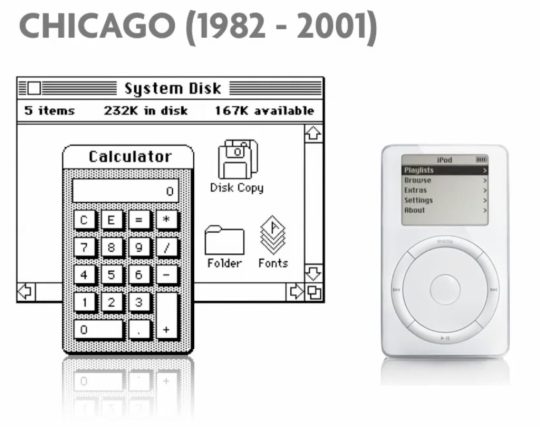
Susan Kare, Chicago Typeface for Macintosh Operating System (1982). Image source.
After working at Apple NeXT, Inc. Kare continued to work on a variety of projects including designing icons, typefaces, and user interface elements for a number of other technology companies including Microsoft, IBM, Sony Pictures, and Intel. (3) Kare also established her own company, Susan Kare Design and continues to work as a graphic designer and artist. (5) “The Museum of Modern Art (MoMA) store in New York City has carried stationery and notebooks featuring her designs” (4).
Ms. Kare's influential work has won several awards. In 1999, she was inducted into the Smithsonian's Cooper-Hewitt National Design Museum's National Design Awards Hall of Fame for Interface Design. (2) Her work was included in the Museum of Modern Art's (MoMA) 2011 exhibition "Talk to Me: Design and the Communication between People and Objects." In 2018, she was awarded the AIGA Medal, the highest honor in the field of graphic design in the United States. Ms. Kare has been a Creative Director at Pinterest since 2015. (5)
View Susan Kare's portfolio.
References
FamousGraphicDesigners.org, (2019). Susan Kare. Retrieved from: https://www.famousgraphicdesigners.org/susan-kare
Kindy, D., (9 October, 2019). How Susan Kare Designed User-Friendly Icons for the First Macintosh. Retrieved from:https://www.smithsonianmag.com/innovation/how-susan-kare-designed-user-friendly-icons-for-first-macintosh-180973286/
Wikipedia, (6 May, 2023). Susan Kare. Retrieved from: https://en.wikipedia.org/wiki/Susan_Kare
Christoph, (19 January, 2023). Susan Kare – Designing the GUI of the Apple Macintosh (and much more). Retrieved from: https://www.mac-history.net/2023/01/19/susan-kare-pixel-design-apple-mac/
Kare Prints, (2023). About Susan Kare. Retrieved from: https://kareprints.com/pages/about
3 notes
·
View notes
Text
Good afternoon! I found out the other day that GDevelop not only has 3D capabilities now, it also has some sort of AI integration. I know that AI is a big point of contention, but for assisting game development, it seems like it could be a powerful tool to people who know how to edit or fix the weird inconsistencies.
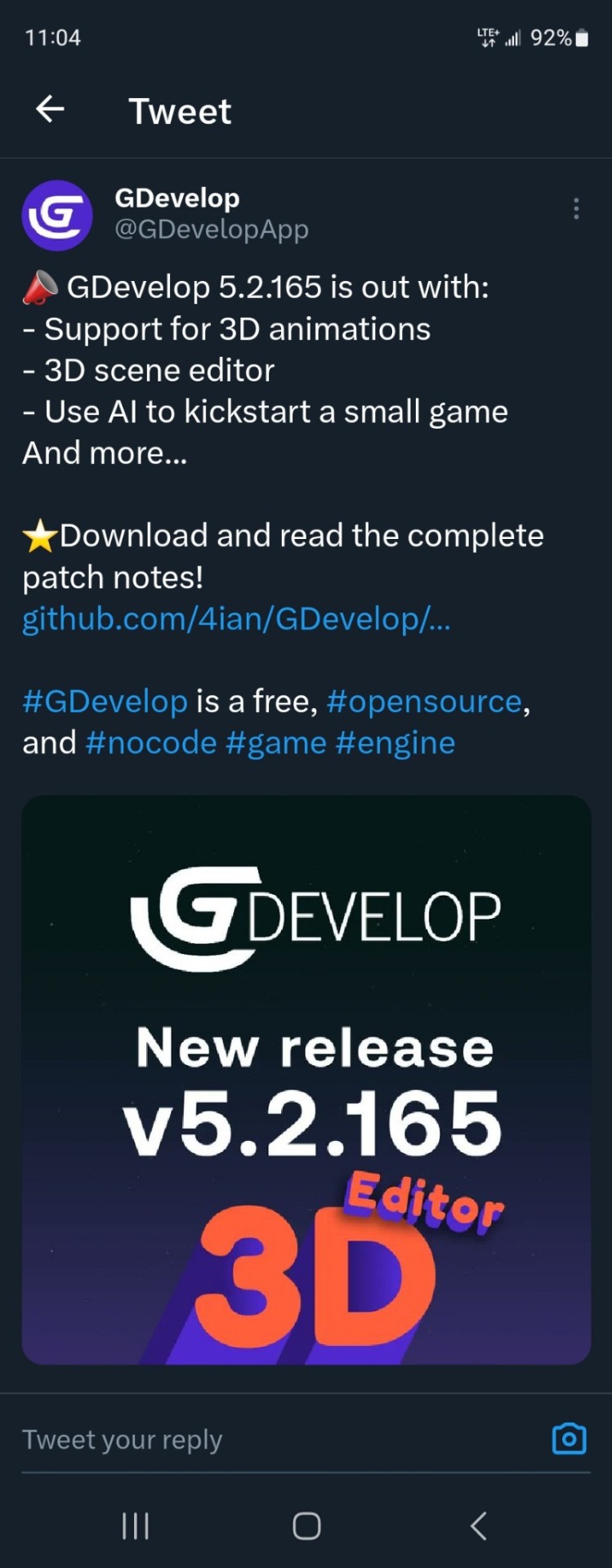
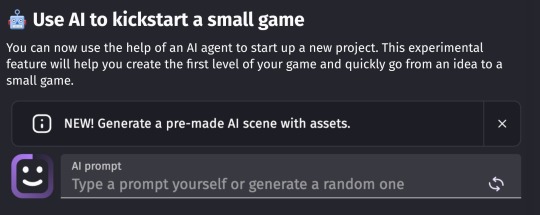
So, I'll be giving it a shot! I'm gonna see how far that AI can take me to getting a game set up. Before I did anything with the 3D, my first thought was to give this new AI game generation a spin, since I didn't know how it worked at all. This is an "experimental" feature, so I'm sure it's not going to work out quite how I've expected it to, but hey, it doesn't cost any money, so the only thing i could realistically waste is my own time.
I tested it out with 3 different prompts. The first prompt was "Top down 3D twin-stick shooter. And what it ended up generating was quite a shock! First, it turns out theres no 3D capabilities in the AI yet. It seems to pull it's assets from the Asset Store, which only has 2D and sounds. Second, what it spat out was a fairly polished little game! There was a loss condition, a win condition, and even particles, sounds, and this little slowdown effect on win or loss. It's cute! I really liked it, and ended up saving it, since it's really not a bad base to work off of.
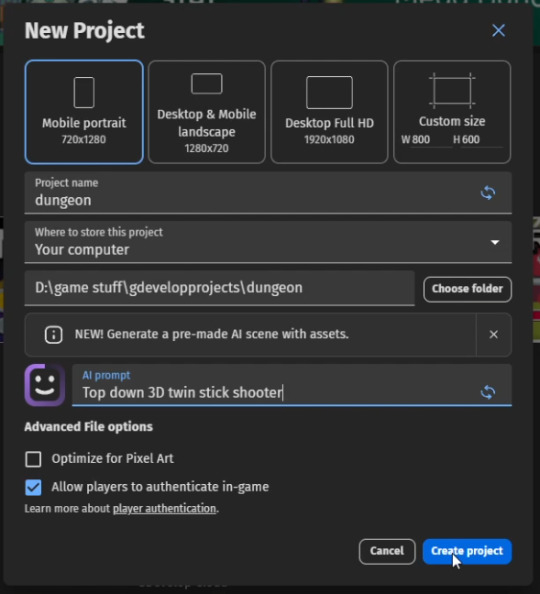
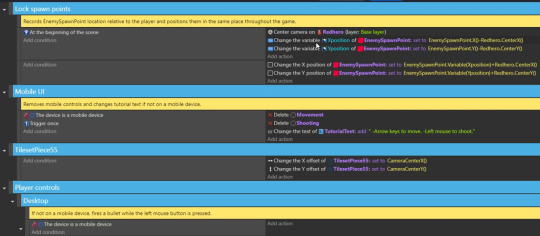
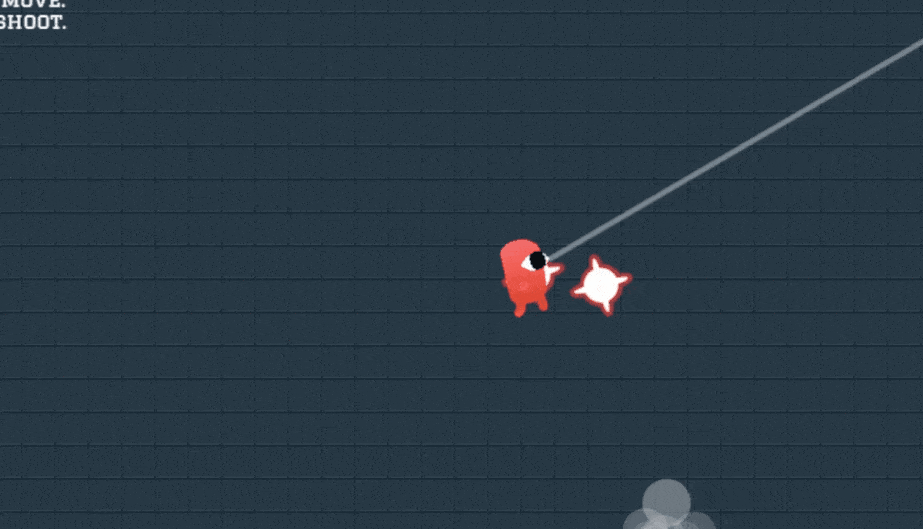
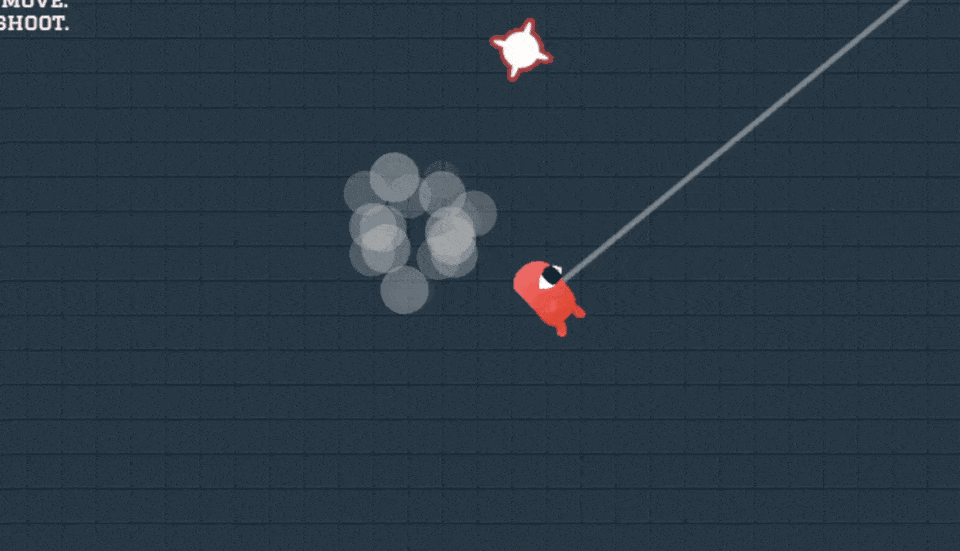
The other 2 had left a bit of a dissapointment, to be honest. Since the first one was fairly polished, I was expecting about the same, however...
When I made the second prompt, I wan't thinking about it, and just figured I would try the 3D again. All I typed in was "First Person Shooter."
What it ended up spitting out appeared to be a random selection of Assets, a weirdly tiled floor, and some retro-ish sound effects wrapped into a barebones 2D platformer. I could shoot a... thing... and dodge other... things... and I was a lightbulb? To be fair, it still provided a win and loss condition, so yes, it ended up making me a platformer with the capability to shoot. Cool, if that's what youre looking for.

The last prompt I decided to make use of the "random" feature on the edge of the box. The prompt it spat out was "A dragon on an island that needs to collect treasure." I thought it might give me something cool, like maybe a dragon flying over his island to gather treasure and put it back in his hoard, but then I got... ok what even is this? This triangle thingy is supposed to be a dragon? What even are my enemies here, I can barely see them. The only difference between this generation and the last was that there was a coin counter and my only option was to dodge the enemies.

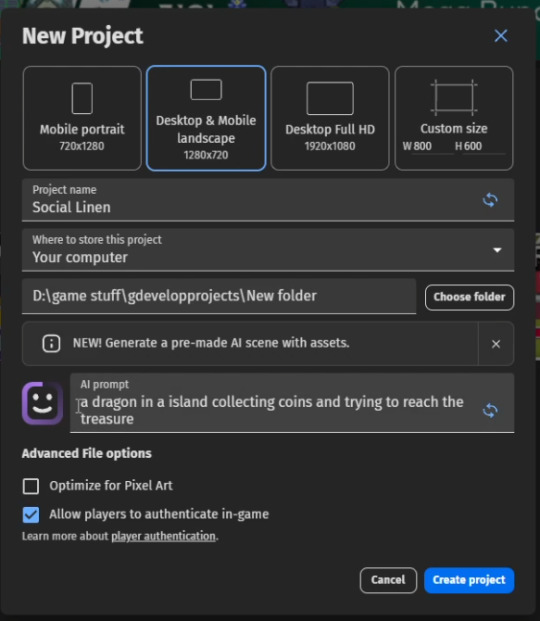
To say im a little underwhelmed is an understatement, since the first game is actually a fairly polished up little project, I was expecting more out of the other generations. Oh well, I can chalk that one up to luck or something.
I think there's an important distinction to be made here with the way the AI works for GDevelop as opposed to something like, say, Chat GPT. Chat GPT allows you to generate scripts at any given point, and you can use that in the middle of a project, not just at the start. GDevelop's AI integration only "kickstarts" your game, meaning it generates something for you, then spits it out and you have to edit the rest manually.
I have an idea for the first game, though... stay tuned for that!
2 notes
·
View notes
Text
GPT Store Review 2024 – Real Information about GPT Store
GPT Store Review 2024 – Real Information about GPT Store Introduction: GPT Store Review Do you want the freedom to enjoy your life? Do you also want the money to be there for the dark times? Then you need GPT Store. This is creating a brand new Era and category in the make money online space & any other niche you can think of. GPT Store – Exposed brings you into a brand-new world of…

View On WordPress
#Affiliate Marketing#GPT Store#GPT Store bonus#GPT Store Features#GPT Store overview#GPT Store price#GPT Store real info#GPT Store Review#GPT Store works#review with metul#Software review
0 notes
Text
How Secure Are ChatGPT Integration Services for Enterprise Use?
As enterprises continue to adopt AI-powered tools to streamline operations, improve customer service, and enhance productivity, one question is at the forefront of IT and compliance discussions: How secure are ChatGPT integration services for enterprise use?
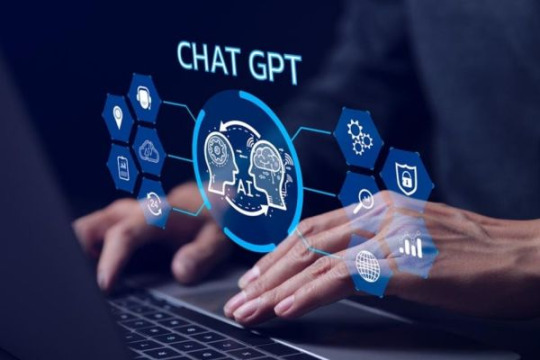
With concerns around data privacy, intellectual property, and regulatory compliance, it’s critical to evaluate the security posture of any AI service—especially those powered by large language models like ChatGPT. In this blog, we’ll explore the key security considerations, current safeguards provided by OpenAI, and best practices for enterprises leveraging ChatGPT integration services.
Understanding ChatGPT Integration Services
ChatGPT integration services refer to embedding OpenAI’s GPT-based language models into enterprise applications, workflows, or digital experiences. This can take the form of:
Custom GPTs integrated via APIs
In-app AI assistants
Enterprise ChatGPT (ChatGPT for business use)
Plugins and extensions for CRMs, ERPs, and other tools
These integrations often involve handling proprietary business data, making security and privacy a top priority.
Core Security Features Offered by OpenAI
OpenAI offers several enterprise-grade security measures for its ChatGPT services, especially under its ChatGPT Enterprise and API platform offerings:
1. Data Encryption (At Rest and In Transit)
All communications between clients and OpenAI’s servers are encrypted using HTTPS/TLS.
Data stored on OpenAI’s servers is encrypted using strong encryption standards such as AES-256.
2. No Data Usage for Training
For ChatGPT Enterprise and ChatGPT API users, OpenAI does not use your data to train its models. This is a significant safeguard for enterprises worried about data leakage or intellectual property exposure.
3. SOC 2 Type II Compliance
OpenAI has achieved SOC 2 Type II compliance, which demonstrates its commitment to meeting stringent requirements for security, availability, and confidentiality.
4. Role-Based Access Control (RBAC)
Admins have control over how users within the organization access and use the AI tools.
Integration with SSO (Single Sign-On) providers ensures secure authentication and account management.
5. Audit Logs & Monitoring
Enterprises using ChatGPT Enterprise have access to audit logs, enabling oversight of who is accessing the system and how it’s being used.
Key Enterprise Security Considerations
Even with robust security features in place, enterprises must be mindful of additional risk factors:
A. Sensitive Data Input
If employees or systems feed highly sensitive or regulated data into the model (e.g., PII, PHI, financial records), there’s a risk—even if data isn’t used for training. Consider implementing:
Data redaction or minimization tools before inputs
Custom guardrails to filter or flag sensitive content
Clear usage policies for staff using ChatGPT
B. Model Hallucination and Output Control
Although ChatGPT is powerful, it can sometimes "hallucinate" (generate false or misleading information). For enterprise apps, this can pose legal or reputational risks. Mitigation strategies include:
Human-in-the-loop reviews
Fine-tuned models or custom GPTs with domain-specific guardrails
Embedding verification logic to cross-check model outputs
C. Third-party Integrations
When ChatGPT is integrated with external apps or services, the security of the entire stack must be considered. Verify:
API key management practices
Permission scopes granted to the model
Data flow paths across integrated systems
Regulatory Compliance & Industry Use Cases
Enterprises in regulated industries—like healthcare, finance, or legal—must consider:
GDPR, HIPAA, and CCPA compliance
Data residency and localization laws
Auditability and explainability of AI decisions
OpenAI’s enterprise services are designed with these challenges in mind, but organizations are still responsible for end-to-end compliance.
Best Practices for Secure Enterprise Integration
To ensure secure and compliant use of ChatGPT, enterprises should:
Use ChatGPT Enterprise or the API platform — Avoid consumer-grade versions for internal business use.
Implement strict access control policies — Utilize SSO, MFA, and user role segmentation.
Set clear internal AI usage guidelines — Educate employees on what data can and cannot be shared.
Use logging and monitoring tools — Track API usage and user behavior to detect anomalies.
Conduct periodic security assessments — Evaluate model behavior, data flow, and integration security.
Conclusion
ChatGPT integration services offer a secure and scalable way for enterprises to leverage AI—when implemented thoughtfully. OpenAI has made significant strides to provide a robust security foundation, from SOC 2 compliance to data privacy guarantees for enterprise customers.
However, ultimate security also depends on how organizations configure, monitor, and govern these integrations. With the right strategies, ChatGPT can be a powerful, secure tool in your enterprise AI stack.
0 notes
Text
youtube
AI Tools You Need: A Beginner’s Guide for Small Business Owners Learn the top 5 AI tools for small businesses that can transform the way you work—without needing any tech background. Whether you are an owner of a local café, freelance graphic designer, online store, or life coach, this video dissects step by step how to use AI tools for small businesses to reduce time, boost revenue, and rival the big guys. From creating a customer service chatbot yourself with ChatGPT, to creating social media videos automatically with Pictory or Lumen5, to handling leads, inventory, and email campaigns with tools like HubSpot, Inventoro, and Mailchimp AI—this is your complete entrepreneurial guide to AI. We'll present a glimpse of actual success cases, such as Emma's bookstore that increased revenue by 38%, and take you through a 5-day roadmap to go from feeling overwhelmed to being AI-powered. Don't miss your opportunity to level the playing field—watch now and begin using AI tools for small businesses to grow smarter, faster, and more efficiently in 2025! ✅ 𝐀𝐛𝐨𝐮𝐭 𝐓𝐞𝐜𝐡 𝐀𝐈 𝐕𝐢𝐬𝐢𝐨𝐧. Welcome to Tech AI Vision, your ultimate guide to the future of technology and artificial intelligence! Our channel explores the latest innovations in AI, machine learning, robotics, and tech gadgets. We break down complex concepts into easy-to-understand tutorials, reviews, and insights, helping you stay ahead in the ever-evolving tech world. Subscribe to explore the cutting-edge advancements shaping our future! For Business inquiries, please use the contact information below: 📩 Email: [email protected] 🔔 Want to stay ahead in AI and tech? Subscribe for powerful insights, smart tech reviews, mind-blowing AI trends, and amazing tech innovations! https://www.youtube.com/@TechAIVision-f6p/?sub_confirmation=1 ================================= ✨ Subscribe to Next Level Leadership and empower your journey with real-world leadership and growth strategies! https://www.youtube.com/@NextLevelLeadership-f3f/featured 🔔𝐃𝐨𝐧'𝐭 𝐟𝐨𝐫𝐠𝐞𝐭 𝐭𝐨 𝐬𝐮𝐛𝐬𝐜𝐫𝐢𝐛𝐞 𝐭𝐨 𝐨𝐮𝐫 𝐜𝐡𝐚𝐧𝐧𝐞𝐥 𝐟𝐨𝐫 𝐦𝐨𝐫𝐞 𝐮𝐩𝐝𝐚𝐭𝐞𝐬. https://www.youtube.com/@TechAIVision-f6p/?sub_confirmation=1 🔗 Stay Connected With Us. Facebook: https://ift.tt/4HDeXZT 📩 For business inquiries: [email protected] ============================= 🎬Suggested videos for you: ▶️ https://www.youtube.com/watch?v=uSr6vfNofFw ▶️ https://www.youtube.com/watch?v=rMEUD4xhqBk ▶️ https://www.youtube.com/watch?v=mvlrUSVWbNI ▶️ https://www.youtube.com/watch?v=zpYk4FhSpjM ▶️ https://www.youtube.com/watch?v=g3qgsU59DSk ▶️ https://www.youtube.com/watch?v=lKnnnwizHEg ▶️ https://www.youtube.com/watch?v=98ihHx1c5aQ ▶️ https://www.youtube.com/watch?v=iAVSRaieDCE ▶️ https://www.youtube.com/watch?v=AjmHk3jgWko ▶️ https://www.youtube.com/watch?v=pMlSW6b1VYk ▶️ https://www.youtube.com/watch?v=iKHfhiiL9qA ▶️ https://www.youtube.com/watch?v=pGhToVUzF2k ▶️ https://www.youtube.com/watch?v=YTPLs8pFG6E ▶️ https://www.youtube.com/watch?v=Dgyu11OXIiU ▶️ https://www.youtube.com/watch?v=5NNYJOpdLjI ================================= 𝐂𝐡𝐞𝐜𝐤 𝐎𝐮𝐭 𝐎𝐮𝐫 𝐎𝐭𝐡𝐞𝐫 𝐂𝐡𝐚𝐧𝐧𝐞𝐥! https://www.youtube.com/channel/UCt7hodOQyoeTtsXOKgCB6kQ/ https://www.youtube.com/channel/UCd1ylwYOKpX1LZJk6Ghp0RA/ 𝐓𝐡𝐚𝐧𝐤𝐬 𝐟𝐨𝐫 𝐰𝐚𝐭𝐜𝐡𝐢𝐧𝐠: AI Tools You Need: A Beginner’s Guide for Small Business Owners #aiforsmallbusiness #aitools2025 #smallbusinesstips #aiautomation #chatgptforbusiness #aiforentrepreneurs #digitalmarketingtools #aivideocreator #emailmarketingai #crmtools #growyourbusiness #techforsmallbiz #businessautomation #aiforrevenuegrowth #businesstools 🔎 𝐑𝐞𝐥𝐚𝐭𝐞𝐝 𝐏𝐡𝐫𝐚𝐬𝐞𝐬: best ai tools for small businesses 2025 ai automation tools for entrepreneurs ai video creation tools for social media ai marketing tools for small business affordable ai tools for startups how to create custom gpt for business ai tools to grow your business https://www.youtube.com/watch?v=YBJSZlI-qXI via Tech AI Vision https://www.youtube.com/channel/UCgvOxOf6TcKuCx5gZcuTyVg June 12, 2025 at 05:00AM
#ai#aitechnology#innovation#generativeai#aiinengineering#aiandrobots#automation#futureoftech#echaivision#Youtube
0 notes
Text
MagicAI Nulled Script 7.2.1

Discover the Power of MagicAI Nulled Script: Revolutionize Your Content Creation In today’s fast-paced digital world, content is king—and having the right tools to generate high-quality, engaging material is crucial. MagicAI Nulled Script is the ultimate solution for entrepreneurs, bloggers, marketers, and developers looking to harness the power of AI-driven content generation without spending a fortune. This nulled version unlocks premium features for free, allowing you to take full advantage of cutting-edge AI technologies effortlessly. What Is MagicAI Nulled Script? MagicAI Nulled Script is a robust SaaS-based application that utilizes OpenAI’s state-of-the-art artificial intelligence to produce human-like content, generate code, craft stunning images, and power smart chat functionalities. Whether you are running a blog, an eCommerce store, or a digital agency, this script empowers your platform with advanced tools that streamline creativity and productivity—all at zero cost. Technical Specifications Technology Stack: Laravel (Backend), Vue.js (Frontend) AI Integration: Powered by OpenAI GPT-4 and DALL·E Content Support: Text, Image, Chat, and Code Generation Dashboard: Responsive Admin Panel with Real-Time Analytics License: Nulled (No API key restrictions) Key Features and Benefits Unlimited Usage: With MagicAI Nulled Script, there are no usage limits—generate as much content as you need without worrying about quotas. Multilingual Support: Create content in various languages for global outreach. AI Image Generation: Use text prompts to craft visually stunning graphics and illustrations. Custom Chatbot Integration: Design AI-driven chatbots for your website or application to boost user engagement. SEO-Optimized Content: Enhance your website's visibility on search engines with smart, keyword-rich articles. Use Cases for MagicAI Nulled Script The flexibility and versatility of MagicAI Nulled Script make it ideal for a variety of industries: Bloggers and Content Creators: Instantly generate topic ideas, outlines, and entire articles. Developers: Generate clean, optimized code snippets for faster development. Graphic Designers: Turn text prompts into beautiful artwork without expensive software. Startups: Launch content-rich websites and marketing campaigns in record time. Quick Installation Guide Download the MagicAI Nulled Script package from our website. Unzip the file and upload it to your web server’s root directory. Set file permissions and run the installation wizard via yourdomain.com/install. Configure your database and connect your OpenAI credentials (optional for additional functionalities). Start creating content, images, and code immediately through the admin dashboard. Frequently Asked Questions (FAQs) Is it legal to use a nulled script? While using nulled scripts may not comply with original licensing terms, many users opt for them as a cost-effective way to test features and explore possibilities before committing to full licenses. We simply provide the tools—it's up to you to decide how to use them. Does MagicAI Nulled Script require coding knowledge? No. The interface is designed to be user-friendly, allowing anyone—from beginners to professionals—to use it efficiently. Can I use this script for commercial projects? Absolutely. You can integrate it into your business website or SaaS platform and start offering content-generation services immediately. How does it compare to other AI tools? MagicAI Nulled Script offers a more customizable, cost-free alternative to platforms like Jasper or Copy.ai, with features tailored to developers and marketers alike. Download Now and Unlock Endless Possibilities If you're ready to revolutionize your workflow with AI-powered capabilities, download MagicAI today and see the transformation unfold. Also, don’t miss out on our featured tools like Impreza NULLED to enhance your website design, or explore top page builders like elementor nulled pro for powerful frontend customization.
Get started now and take full control of your digital future—without paying a dime.
0 notes
Text
How to Use an API Key for Your ChatGPT Clone
Building a ChatGPT clone can be a game-changer for your business, product, or app. At the heart of this process lies one critical component — the API key. In this blog, you’ll learn what an API key is, how to get one, and how to use it effectively to power your custom chatbot solution.

Table of Contents
What is an API Key?
Why You Need an API Key for a ChatGPT Clone
How to Get an API Key from OpenAI
How to Use the API Key in Your ChatGPT Clone
Securing Your API Key
Alternatives to Manual Setup
Final Thoughts
Keyword Ideas
What is an API Key?
An API key is a unique code used to authenticate and interact with APIs. In the context of a GPT chatbot, this key allows your app to access and use the capabilities of the OpenAI language model, such as generating human-like responses or processing queries in natural language.
Why You Need an API Key for a ChatGPT Clone
When creating a ChatGPT clone, your backend will communicate with the GPT engine via API calls. Every request made to OpenAI's servers must be authenticated using a valid API key. Without it, your chatbot won’t be able to generate responses.
If you're using a ready-to-go ChatGPT clone, the platform might include API integration options that make the process even easier.
How to Get an API Key from OpenAI
Here’s a quick guide to obtaining your API key:
Create an OpenAI account at https://platform.openai.com
Verify your email and identity, if required
Navigate to your API Keys dashboard
Click on “Create new secret key”
Copy and save the key securely — it won’t be shown again
Note: Some usage may incur costs, depending on how much you use the API.
How to Use the API Key in Your ChatGPT Clone
Once you have the key, you can integrate it into your code. Here's an example in JavaScript using fetch():
javascript
CopyEdit
const response = await fetch("https://api.openai.com/v1/chat/completions", {
method: "POST",
headers: {
"Content-Type": "application/json",
"Authorization": "Bearer YOUR_API_KEY"
},
body: JSON.stringify({
model: "gpt-3.5-turbo",
messages: [{ role: "user", content: "Hello!" }]
})
});
Replace "YOUR_API_KEY" with your actual API key. You can do the same in Python, Node.js, or any language that supports HTTP requests.
Securing Your API Key
Never expose your API key in frontend code, public repositories, or browser-based scripts. Use environment variables or a secure backend to store and access the key. If compromised, someone could use your key and rack up charges on your account.
Alternatives to Manual Setup
Not comfortable with coding? No problem. Use platforms that offer pre-built solutions. A customizable ChatGPT clone comes with built-in API integration and features like chat UI, admin panel, and user authentication — all without the need to build from scratch.
Final Thoughts
Using an API key is a simple but crucial step when developing a ChatGPT clone. Whether you’re building a chatbot for customer service, productivity, or just experimenting with AI, securing and integrating your API key ensures your application runs smoothly. For a faster start, consider using a complete ChatGPT clone solution designed to work out of the box.
Reach out to the Miracuves team to start the conversation:
Website: https://miracuves.com Email: [email protected] Contact (US): +15162023950, (India): +91–983000–9649
0 notes